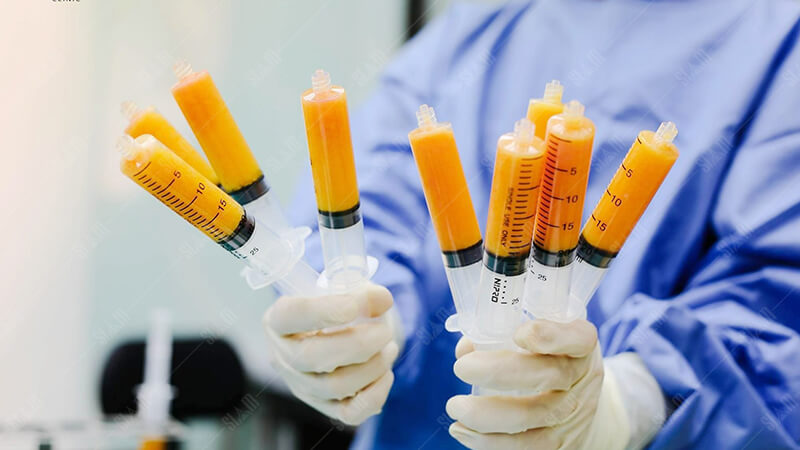Date posted: 28-10-2024 | Last updated : 04-11-2024

Over time, aging signs gradually appear on the face, causing many people to lose confidence. Wrinkles, deep folds, and hollowed-out areas are common issues that affect youthful beauty. In these cases, fat grafting provides an effective and safe solution for facial rejuvenation.
Fat grafting is a method that uses the client's own excess fat to inject into areas that need volume restoration or contouring. This technique can be applied to fill sunken cheeks, smile lines, create a V-line chin, and enhance areas such as the breasts, buttocks, and even rejuvenate the hands. The fat is typically harvested from areas like the abdomen, thighs, or arms, processed to remove impurities, and then injected into the targeted areas for a fuller, more youthful appearance.

Autologous fat grafting is a method of using excess fat from the client's body to graft into areas that need filling.
Fat grafting has become increasingly popular due to its high versatility and outstanding aesthetic results. This method not only helps remove excess fat but also creates perfect contours on the body.
Fat grafting is considered a relatively safe cosmetic procedure, especially when performed by highly skilled doctors at reputable medical facilities. Since the procedure uses the client's own fat, it has a high compatibility rate and minimizes the risk of allergic reactions. The fat transfer process is gentle and causes minimal discomfort, leading to a quicker recovery time. This makes fat grafting a “2-in-1” beauty solution, as it reduces excess fat while filling areas that lack volume.
However, like any other cosmetic procedure, autologous fat grafting also carries certain risks such as infection, swelling, loss of sensation, etc. if not performed properly. Therefore, to ensure safety, customers need to choose a cosmetic facility with a business license, modern equipment and a team of experienced doctors.
Fat grafting is a versatile cosmetic procedure that can be applied to various parts of the body to enhance contours and add volume. Below are some common areas where fat grafting is performed:

Facial fat grafting is a procedure that uses excess fat from areas of the body like the abdomen, thighs, or arms, which is then injected into hollow areas of the face to make it fuller and more youthful. Before injecting, the fat is purified in a centrifuge to isolate the healthiest fat cells.
Facial fat grafting is commonly applied to specific areas, including:

Facial fat grafting helps the face to be balanced and youthful.
Autologous fat grafting to plump the face is an effective solution for many people, particularly in the following cases:
- Individuals with thin faces, sunken cheeks, deep nasolabial folds, or hollow temples.
- Those looking to enhance facial features and create softer, more harmonious facial lines.
- People seeking to rejuvenate their skin by filling wrinkles and deep grooves, resulting in smoother, more youthful-looking skin.
- Candidates in good health who do not have chronic illnesses or take anticoagulants.

People with thin, gaunt faces should consider facial fat grafting
Below are the detailed steps in the facial fat grafting procedure performed by Dr. Richard Huy:
Step 1: Doctor consultation and facial assessment
The doctor will thoroughly examine the face to identify areas that need correction, such as the hollow under the eyes, temples, nasolabial folds, and wrinkles. Based on this, the doctor will provide a suitable fat grafting plan for the client.
Step 2: Preparing health before the fat grafting procedure
The doctor will request that you undergo basic tests, such as blood and urine tests, to ensure the client is healthy enough for the procedure. Clients will be informed about the process, important precautions before and after the procedure, and will receive guidance on how to take care of themselves for the best results.
Step 3: Anesthesia
Depending on the fat extraction location, the scale, and the complexity, the doctor may choose local anesthesia or general anesthesia to ensure the client does not feel any pain.
Step 4: Fat extraction
Depending on the client's body, the doctor will choose an area with excess fat such as the abdomen, thighs, or calves to remove fat. The doctor will use a specialized liposuction tube to remove a sufficient amount of fat from the selected area, ensuring that the surrounding tissues are not damaged.
Step 5: Fat processing
After being removed, the fat will be put into a centrifuge system to remove impurities and water, keeping only pure fat cells.
After being purified, the fat will be prepared in specialized syringes, ready for the step of implanting into the face.

Step 6: Fat grafting procedure
The doctor will inject the fat into the predetermined areas using precise injection techniques, applying thin layers to ensure a natural and even result. After the injections, the doctor will re-examine the entire face and make any necessary adjustments to achieve the best aesthetic outcome.
Step 7: Post-procedure care
Clients will be given instructions on how to care for their face after the fat grafting, including avoiding strong impacts, keeping the area clean, and using skincare products as directed by the doctor. A follow-up appointment will be scheduled to monitor the fat absorption and ensure the desired results are achieved.
According to Dr. Richard Huy, facial fat grafting offers numerous benefits, including:
- Natural facial rejuvenation: Facial fat grafting helps fill in sunken areas such as hollow cheeks, deep smile lines, under-eye hollows, and wrinkles, resulting in a youthful and refreshed appearance. Since the procedure uses the client’s own fat, it produces natural, harmonious results without the stiff or artificial look that some other methods can cause.
- Safe and low risk: Using autologous fat has high compatibility, completely eliminating the risk of allergic reactions or rejection by the body, making it a very safe procedure. As no artificial materials or foreign chemicals are introduced into the body, the risk of complications or side effects is minimal. Fat grafting also causes less tissue damage, leading to faster recovery times.
- Long-lasting results: Once the transplanted fat has stabilized in the face, clients do not need to undergo frequent injections or touch-ups as with fillers. This helps save time, effort, and costs in maintaining the desired appearance.
- Two-in-one beauty solution: The facial fat grafting procedure provides dual benefits, improving targeted areas of the face while also helping reduce fat in other parts of the body. This makes it an ideal option for those looking to enhance their overall beauty efficiently.

Facial fat grafting helps create a youthful and radiant face
Proper care of the face after autologous fat grafting is crucial to ensure the fat is well absorbed and to achieve optimal aesthetic results. Below are detailed guidelines for post-procedure care:

Take antibiotics, anti-inflammatory medication, and pain relievers as prescribed by your doctor.
The fat grafting process is performed under local anesthesia, ensuring that the patient does not feel pain during the procedure. Moreover, facial fat grafting is a minimally invasive method, using only small needles to inject fat into the face. Therefore, it causes minimal damage to tissues and nerves, reducing the sensation of pain.
The effects of facial fat grafting can last from 1 to 2 years or more. Following the doctor's aftercare instructions carefully will help maintain the results for a longer period. However, fat grafting is not a permanent solution, as some of the transferred fat may gradually be absorbed by the body over time.
Swelling after facial fat grafting typically subsides after 7 to 10 days, depending on each person's body and aftercare. Doctors often recommend cold compresses for the first two days, drinking plenty of water, elevating the head while sleeping, and avoiding activities that put pressure on the face to reduce swelling effectively.
If the swelling does not improve after about two weeks, patients should consult their doctor for an examination.
Facial fat grafting is an effective way to rejuvenate the face. With his expertise and skill, Dr. Richard Huy can deliver outstanding aesthetic results. Don’t hesitate to contact him for a consultation and check-up.